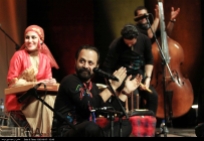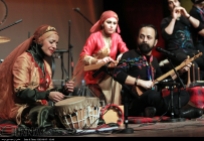Chaharshanbe Suri is an ancient ceremony dating back to at least 1700 BCE. Iran’s largest dictionary, Dehkhoda, describes it as: “A festival arranged on the last Tuesday evening of the old year, where you light fires and jump over them, to achieve happiness and good health in the New Year.”
The celebration usually starts in the evening and people leap over the flames, singing “zardi-ye man az toh, sorkhi-ye toh az man”, literal translated as “my yellow is yours, your red is mine”, asking the fire to take their pallor, sickness, and problems and in turn give them redness, warmth, and energy.
Traditionally, it is believed that the living were visited by the spirits of their ancestors on the last day of the year. Many people specially children, wrap themselves in shrouds symbolically reenacting the visits. By the light of the bonfire, they run through the streets banging on pots and pans with spoons (“Gashog-Zani”) to beat out the last unlucky Wednesday of the year, while they knock on doors to ask for treats. Sometimes the treat is a mixture of seven dried nuts and fruits (pistachios, roasted chic peas, almond, hazelnuts, figs, apricots, and raisins) and is called “Ajeel-e Chahar Shanbeh Suri”. The practices are very similar to Halloween, which is a Celtic version of similar festivals celebrated throughout the area in ancient times.

Chaharshanbe Suri – Ancient Fire Festival – Celebration in Iran, 2016 (Photo: IRNA)

Chaharshanbe Suri – Ancient Fire Festival – Celebration in Iran, 2016 (Photo: IRNA)

Chaharshanbe Suri – Ancient Fire Festival – Celebration in Iran, 2016 (Photo: Mona Hoobehfekr / ISNA)

Chaharshanbe Suri – Ancient Fire Festival – Celebration in Iran, 2016 (Photo: Amir Ali Razzaghi / Mehr News Agency)

Chaharshanbe Suri – Ancient Fire Festival – Celebration in Iran, 2016 (Photo: IRNA)

Chaharshanbe Suri – Ancient Fire Festival – Celebration in Iran, 2016 (Photo: IRNA)

Chaharshanbe Suri – Ancient Fire Festival – Celebration in Iran, 2016 (Photo: Amir Kholousi / ISNA)

Chaharshanbe Suri – Ancient Fire Festival – Celebration in Iran, 2016 (Photo: Amir Kholousi / ISNA)

Chaharshanbe Suri – Ancient Fire Festival – Celebration in Iran, 2016 (Photo: IRNA)

Chaharshanbe Suri – Ancient Fire Festival – Celebration in Iran, 2016 (Photo: IRNA)

Chaharshanbe Suri – Ancient Fire Festival – Celebration in Iran, 2016 (Photo: IRNA)

Chaharshanbe Suri – Ancient Fire Festival – Celebration in Iran, 2016 (Photo: IRNA)
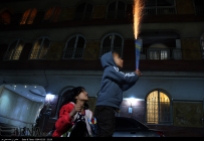
Chaharshanbe Suri – Ancient Fire Festival – Celebration in Iran, 2016 (Photo: IRNA)

Chaharshanbe Suri – Ancient Fire Festival – Celebration in Iran, 2016 (Photo: IRNA)

Chaharshanbe Suri – Ancient Fire Festival – Celebration in Iran, 2016 (Photo: IRNA)

Chaharshanbe Suri – Ancient Fire Festival – Celebration in Iran, 2016 (Photo: IRNA)

Chaharshanbe Suri – Ancient Fire Festival – Celebration in Iran, 2016 (Photo: IRNA)

TEHRAN, IRAN – MARCH 15: An Iranian man flies a sky lantern during the celebrations of Chaharshanbe Suri on the eve of the last Wednesday of the year before Nowruz, in Tehran, Iran on March 15, 2016. (Photo by Fatemeh Bahrami/Anadolu Agency/Getty Images)

Chaharshanbe Suri – Ancient Fire Festival – Celebration in Iran, 2016 (Photo: IRNA)

Chaharshanbe Suri – Ancient Fire Festival – Celebration in Iran, 2016 (Photo: IRNA)

Chaharshanbe Suri – Ancient Fire Festival – Celebration in Iran, 2016 (Photo: IRNA)

Chaharshanbe Suri – Ancient Fire Festival – Celebration in Iran, 2016 (Photo: IRNA)

TEHRAN, IRAN – MARCH 15: A woman holds a torch during the celebrations of Chaharshanbe Suri on the eve of the last Wednesday of the year before Nowruz, in Tehran, Iran on March 15, 2016. (Photo by Fatemeh Bahrami/Anadolu Agency/Getty Images)

TEHRAN, IRAN – MARCH 15: Iranians fly a sky lantern during the celebrations of Chaharshanbe Suri on the eve of the last Wednesday of the year before Nowruz, in Tehran, Iran on March 15, 2016. (Photo by Fatemeh Bahrami/Anadolu Agency/Getty Images)
Photos: Chaharshanbe Suri in Iran, 2016
Families customarily enjoy snacks during the evening and a supper at night after the end of the festivities. In Kerman and Shiraz the main dish is usually polow with pasta soup (“ash reshte“); the longer the pasta strands, the better the chances for a long life for each member of the family.
The ancient Iranians celebrated the last 10 days of the year in their annual feast of all souls, Hamaspathmaedaya (Farvardigan). They believed Foruhars (faravahar), the guardian angels for humans and also the spirits of dead would come back for reunion. These spirits were entertained as honored guests in their old homes, and were bidden a formal ritual farewell at the dawn of the New Year. The ten-day festival also coincided with festivals celebrating the creation of fire and humans. Flames were burnt all night to ensure the returning spirits were protected from the forces of Ahriman. This was called Suri festival. Zoroastrians today still follow this tradition.
The celebration was not held on this night before Islam and might be a combination of different rituals to make them last. Wednesday is likely to have been prompted by an Arab superstition where it represents a bad omen day with unpleasant consequences. This is contrary to Zoroastrian cosmology where all days were sacred and named after a major deity. By celebrating in this manner Iranians were able to preserve the ancient tradition. The festival is celebrated on Tuesday night to make sure all bad spirits are chased away and Wednesday will pass uneventfully.
Today, there is no religious significance attached to it any more and is a purely secular festival for all Iranians (Persians, Azerbaijani people, Armenians, Kurdish people, Assyrians, Bahá’í, Jews, Christian and Zoroastrians). The night will end with more fire works and feasts where family and friends meet and enjoy music and dance.
Chaharshanbe Suri in Tehran, Iran – 2016
Fire Festival in Sweden
In Gothenburg, Stockholm and Malmö, Sweden they celebrate Eldfesten, a Swedish version of the Persian Chaharshanbe Soori. This year, 2016, is the 25th anniversary of the festival in the city of Gothenburg, where it has become one of the most popular public cultural celebrations in the city. Thousands of people, including non-Iranians, attend each year to celebrate the arrival of spring with crackling fires, music, fireworks and fragrant Persian dishes.

Chaharshanbe Suri in Sweden (Eldfesten) – Women in traditional Iranian clothes

Chaharshanbe Suri in Sweden (Eldfesten) – Women in traditional clothes each with one of the seven symbols of the “Haft-Sin” (seven ‘s’) a tradition of Nowruz, the Iranian New Year tradtion

Chaharshanbe Suri in Sweden (Eldfesten)

Chaharshanbe Suri in Sweden (Eldfesten)
Photos: Eldfesten 2016 in Sweden
Sources: Iran Chamber Society, Enciclopædia Iranica, Wikipedia | Chaharshanbe Suri, IRNA 1, IRNA 2, IRNA 3, IRNA 4, IRNA 5, ISNA 1, ISNA 2, Mehr News Agency, Facebook | Eldfesten 2016, Göteborgs-Posten, goteborg.com, Huffington Post Canada






















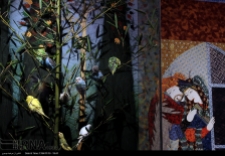










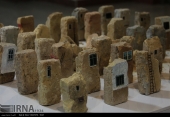







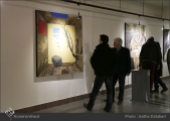















































































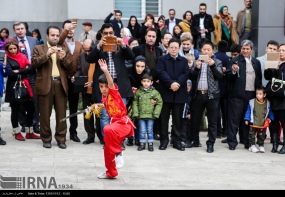


 The story of the film is set somewhere in the outskirts of Tehran, where a small factory illegally employs Afghan asylum seekers, who live with their families in old containers or modest shacks in nearby shanty towns. Saber, a young Iranian worker, secretly meets Marona, daughter of Abdolsalam, an Afghan worker. A love story unfolds. “A Few Cubic Meters of Love” is Jamshid Mahmudi’s debut film, which premiered at the 32nd Fajr International Film Festival in Tehran in February 2014. The film won him the Simorgh for best director in the New View section of the festival. “I would have felt bad had we not won any award at this event,” Jamshid Mahmudi said during the review session. “Because we did our best to make the film be warmly received,” he added.
The story of the film is set somewhere in the outskirts of Tehran, where a small factory illegally employs Afghan asylum seekers, who live with their families in old containers or modest shacks in nearby shanty towns. Saber, a young Iranian worker, secretly meets Marona, daughter of Abdolsalam, an Afghan worker. A love story unfolds. “A Few Cubic Meters of Love” is Jamshid Mahmudi’s debut film, which premiered at the 32nd Fajr International Film Festival in Tehran in February 2014. The film won him the Simorgh for best director in the New View section of the festival. “I would have felt bad had we not won any award at this event,” Jamshid Mahmudi said during the review session. “Because we did our best to make the film be warmly received,” he added.

